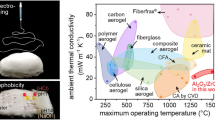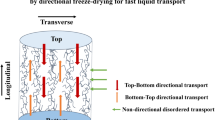Abstract
Porosity control in ceramic membranes has been achieved by controlling particle packing densities in sol-gel processing. TiO2 xerogels with two mean pore radii of 0.7 and 1.7 nm and a porosity varying from 30% to 52% have been obtained. ZrO2 xerogels with a mean pore radius of 0.7 nm and a porosity varying from 7% to 34% have also been prepared. The principle of controlling porosity is to make spongy aggregates and to control the degree of aggregation. Experiments have been conducted to show that spongy aggregates can be produced by gradually removing protons from the strongly charged particles. Viscosity techniques have been used to measure the relative volume fraction of the dispersed phase which, in turn, provides information on aggregate structures. Two aggregation models have been proposed to explain different structural aggregates formed through thermal destabilization in the highly charged system and through charge neutralization by gradually removing charge from the particles in the system.
Similar content being viewed by others
References
U. Merin and G. Daufin, Proc. 1st Int. Conf. on Inorganic Membranes, 271 (1989).
J. L. Branger, R. Audinos, J. Noguera, and M. Chignac, ibid., 243 (1989).
M. Nakajima, N. Jimbo, H. Nabetani, and A. Watanabe, ibid., 257 (1989).
A. Deschamps, C. Walther, P. Bergez, and J. Charpin, ibid., 237 (1989).
R. C. Fablani, R. Vatteroni, C.A. Nannetti, and L. Bimbi, ibid. 497 (1989).
K. Iwamoto, Y.T. Lee, and M. Seno, ibid., 511 (1989).
N. Ito, K. Haratani, and Y. Shindo, Jpn. Kokai Tokyo Koho, 5 (1989).
R. J. R. Uhlhorn, M. H. B. J. Huis in ‘t Veld, K. Keizer, and A. J. Burggraaf, Sci. Ceram. 14, 551 (1988).
R. Maravich, G. P. Sundstrom, and W.T. Bates, Ultrapure Water 6 (6), 18, 20, 22–24, 26, 28 (1989).
Y. Matsumoto and Y. Totsuka, Kagaku Kogaku 51 (10), 764 (1987).
C. E. Megiris, S.W. Nam, and G. R. Gavalas, Proc. 1st Int. Conf. on Inorganic Membranes, 355 (1989).
V.T. Zaspalis, W. van Praag, K. Keizer, J. G. van Ommen, J. R. H. Ross, and A. J. Burggraaf, ibid., 367 (1989).
E. A. Hazbun, U.S. Patent 4791079 (1988).
L.W. Niedrach, Science 207 (4436), 1200 (1980).
S. Hettiarachchi and D. D. Macdonald, J. Electrochem. Soc. 131 (9), 2206 (1984).
Y. S. Lin, L. G. J. DE Haart, K. J. DeVries, and A. J. Burggraaf, Proc. Electrochem. Soc. 89–11 (Proc. Int. Symp. Solid Oxide Fuel Cells, 1st, 1989), p. 67.
J. Sabate, M.A. Anderson, H. Kikkawa, Q. Xu, and C.G. Hill, Jr., Envir. Sci. Tech. (1990, submitted).
Newsfront, Chem. Eng., June 9, 19 (1986).
B. E. Yoldas, J. Mater. Sci. 10, 1856 (1975).
M. A. Anderson, M. J. Gieselmann, and Q. Xu, J. Membr. Sci. 39 (3), 243 (1988).
Q. Xu and M.A. Anderson, in Multicomponent Ultrafine Microstructures, edited by L. E. McCandish, B. H. Kear, D. E. Polk, and R.W. Siegel (Mater. Res. Soc. Symp. Proc. 132, Pittsburgh, PA, 1989), p. 41.
M. J. Gieselmann and M. A. Anderson, J. Am. Ceram. Soc. 72, 980 (1989).
M. Mooney, J. Coll. Sci. 6, 162 (1951).
I. M. Krieger, Adv. Coll. and Interface Sci. 3, 111 (1972).
N. A. Frankel and A. Acrivos, Chem. Eng. Sci. 22, 847 (1967).
N. L. Ackermann and H.T. Shen, A. I. Chem. Eng. J. 25, 327 (1979).
A. L. Graham, Rheology Research Centre Report No. 62, University of Wisconsin, June 1980.
R. K. Her, Colloid Chemistry of Silica and Silicates (Cornell University Press, Ithaca, NY, 1955), p. 96.
M.I. Tejedor-Tejedor and M.A. Anderson, Langmuir 2, 203 (1986).
W. B. Russel, J. Fluid Mech. 85, 673 (1978).
D. A. Lever, J. Fluid Mech. 92, 421 (1979).
W. B. Russel, J. Fluid Mech. 85, 209 (1978).
P. Meakin, Phys. Rev. Lett. 51, 119 (1983).
M. Kolb, R. Botet, and R. Jullien, Phys. Rev. Lett. 51 1123 (1983).
V. A. Hackley and M.A. Anderson, Langmuir 5, 191 (1989).
D.W. Schaefer, J. E. Martin, P. Wiltzius, and D. S. Cannell, Kinetics of Aggregation, edited by F. Family and D. P. Landan (North Holland, New York, 1984).
Author information
Authors and Affiliations
Rights and permissions
About this article
Cite this article
Xu, Q., Anderson, M.A. Synthesis of porosity controlled ceramic membranes. Journal of Materials Research 6, 1073–1081 (1991). https://doi.org/10.1557/JMR.1991.1073
Received:
Accepted:
Published:
Issue Date:
DOI: https://doi.org/10.1557/JMR.1991.1073




